Company history
Classic Audio Ltd. was formed in May 2020 with the goal of making high quality, hand-assembled analogue audio electronics for affordable prices, with an 'old school' approach utilising linear transformer power supplies, through hole components, and new circuit architecture. Once the workshop was properly set up in 2021, work quickly began on a first product. As phono preamplifiers were a particularly weak area of the market, this was a high quality phonostage with excellent technical performance - the Spartan 10, which first went on sale in the UK only in December 2021.
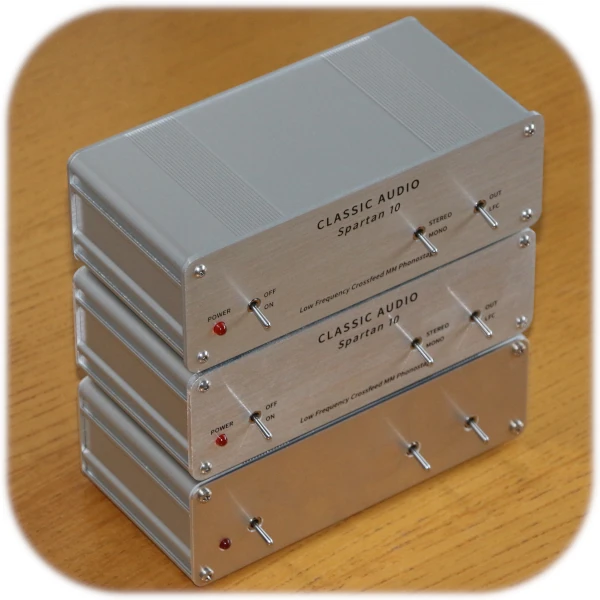
Prototype with first and last production Spartan 10 phonostages
The Spartan 10 quickly became a popular product in the UK, creating a great deal of online chatter alongside some very public meltdowns from at least one competitor! Due to this success and requests from customers, efforts were concentrated on making a full range of phono preamplifiers. After sourcing new enclosures the equally original smaller Spartan 5 phonostage in was released in September 2022, followed up with the MM/MC Pro series phonostages in November of the same year. As the Spartan 10 sold out its production run less than a year after official release, generating a stream of requests for an immediate replacement, work immediately started on the Spartan 15, only just available at the time of writing...
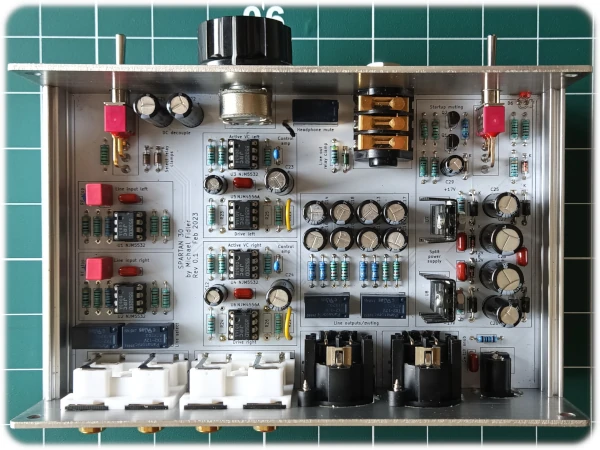
SPARTAN 30 headphone amplifier prototype
From the official release of the MM Pro in February 2023, Classic Audio Ltd. has been supplying customers worldwide with power supplies to suit all regions. Although retailers outside of the UK have repeatedly asked to stock the products, direct selling has been preserved without any retail markup. This keeps final prices as low as possible, but also makes sure the one-man organisation never runs out of stock! It might seem that the company specialises only in phonostages, with customer demand driving the development for a wide range of these devices, but this will change very soon with the completion of the SPARTAN 30 headphone amplifier, to be followed up with (surprise, surpise!) another phonostage, this time for 78 RPM discs.
Design philosophy
High fidelity is the name of the game here; reproducing sound accurately without any contamination or colouration. This means designing circuitry that keeps noise and distortion as low as can be so as not to mask any musical details, while keeping the frequency response as flat as possible for minimal colouration. Having plenty of headroom helps too, so a proper split linear power supply is essential maintain breathing room necessary for excellent dynamics. Before the 1980s manufacturers competed to produce the best measurements for accurate sound, but unfortunately revenue-generating marketing gimmicks and highly subjective testing have reversed this, leading to badly designed gear being marketed as high fidelity with no reference to its technical performance.
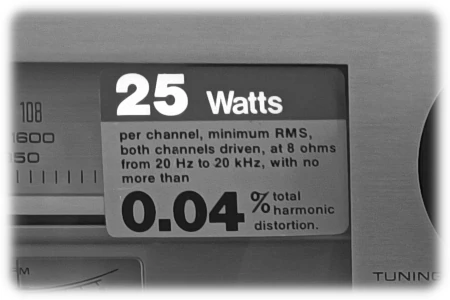
Performance figures front and centre on a 1979 receiver
Products are designed to deliver transparency every time by adhering to the original 'do no harm' principles of high fidelity audio, just like the very best vintage equipment did, but with the added advantages of modern components. Most modern products are marketed based on flashy and exotic components that don't really do anything for the end result, and often make things worse overall. The products on this website take a different approach, focusing on the architecture of the circuity firstly, rather than individual parts. Many ordinary bricks can build a beautiful palace, but a shed built out of gold sheets and platinum nails is still a shed!
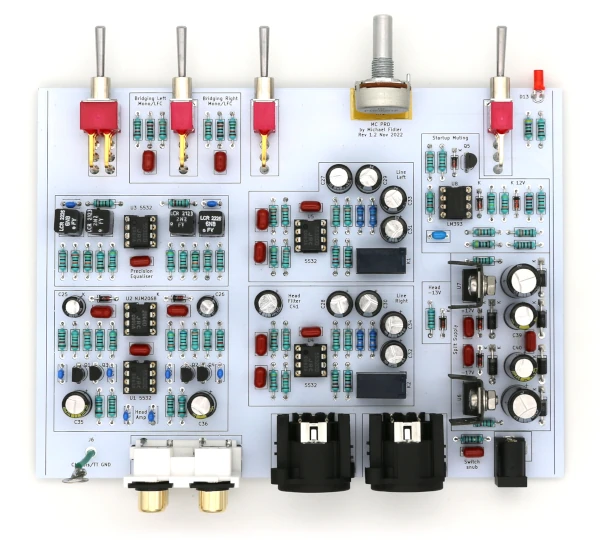
MC PRO PCB layout
The design starts from circuit level, with most of the effort focused on making the architecture and PCB layout as immune to the limitations of the selected components. This is opposed to most other products that design the enclosure first and leave the electronics as an after-thought. By using the strength of the architecture it's possible to create a final product that has much better performance than conventional designs using even the most expensive and esoteric parts available. As the design comes for free after development, this approach yields great value for money as relatively standard parts can be used to make a class-leading product, hence the motto analogue design far greater than the sum of its parts.
Real world performance
All Michael Fidler products are designed for use with real audio signals and not just some nice numbers at a few sweet spots. Distortion is measured at maximum output throughout the practical audio range to make certain that actual with a music signal will be considerably better than this worst-case scenario. No 'a-weighting' is applied to the noise floor either which gives an illusory extra few decibels to the spec sheet, while frequency response is measured primarily as the variation in the audio band - not just where it starts rolling off heavily.
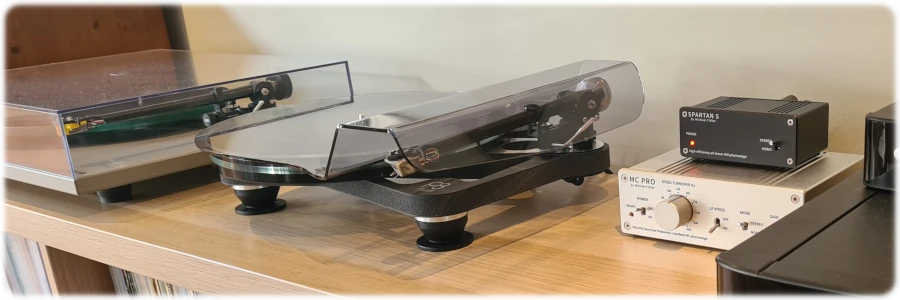
Spartan and Pro phonostages in a high quality setup
Making a nice circuit that gives good numbers when connected to an analyser is all very well, but if it can't perform equally well when used in a real audio setup then it's not very useful at all. That's why all important measurements are made with connections real input sources and line loads, with special attention being paid to immunity to radio frequency interference and rejection of stray magnetic fields on PCB layouts. Line outputs are made strong enough to drive even the most demanding equipment to very high levels without complaint, while phonostages are measured with real cartridges connected to the inputs that don't hide input current noise. All this makes sure that the high performance in the specification sounds just as good as it looks in practice.
Build quality
High quality parts are used throughout the range of products, regardless of price. Lower cost products feature simpler circuitry, but use the same electronic components and connectors as the more sophisticated fully featured versions. Compact sandblasted aluminium enclosures with 6mm CNC milled front panels add weight and stability. All units are come with fully optimised linear power supplies as standard for much greater reliability, isolation, and lower noise than their cheaper and more common switching counterparts. No PSU 'upgrades' needed here - that extra cash can go on records!
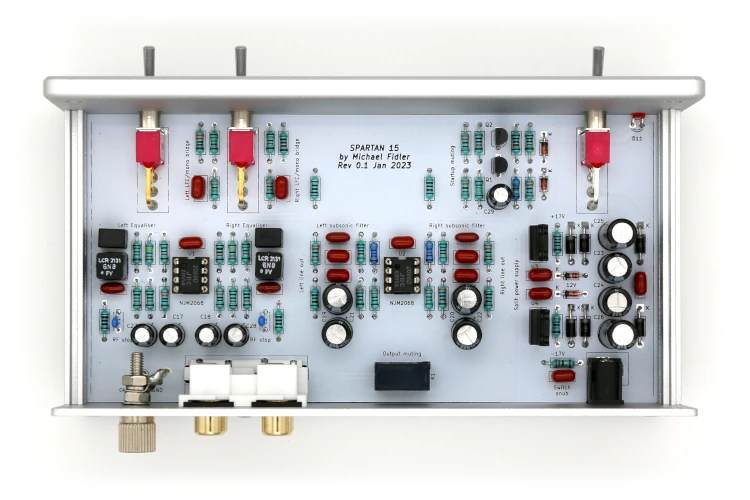
Through hole components inside a SPARTAN 15 phonostage
All components are selected for their practical performance as part of a complete product. The double sided PCBs are populated with distortion-free 1% tolerance metal film resistors, ultra-reliable Panasonic electrolytic capacitors, hand-selected film capacitors, and audio amplifier ICs mounted in turned DIP sockets for easy replacement if they get zapped by external equipment. Specially made gold-plated toggle switches, rated for 50,000 cycles (in contrast to the 10,000 of cheaper push switches), make for highly reliable and noise-free controls with a great action. All through hole technology and standard parts make for easy repair in the unlikely event of failure, so the products can last for many decades to come.
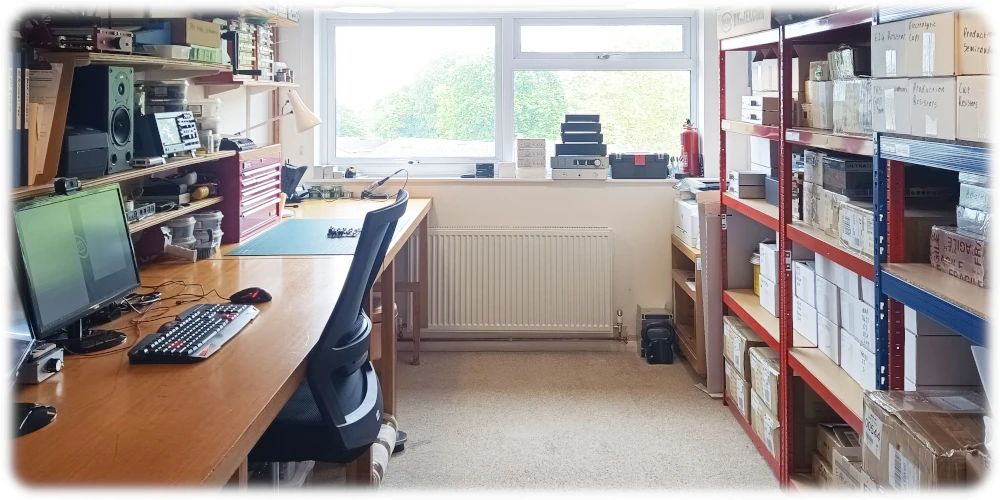
Classic Audio's one-man workshop in Kent, England
Products are built and packed in a state-of-the-art 12m² spare room facility based in Kent in the South East of England - all by just one person, allowing for very tight quality control. PCBs are hand-assembled from component level using lead-free silver solder, inspected, and then tested to specification on a professional distortion analyser (just visible next to the computer monitor) once assembled into a complete product. Small stocks are kept on the shelves of each product so that orders can be sent out immediately once they are placed without waiting on lead time.
Transparency
While many other companies make vague allusions to mysterious proprietary technology, guru designers, and special components, the products here are described in full with thorough descriptions on all technical points. By describing the technical features properly, and backing them up with correctly measured numbers on the spec sheet customers can be sure that they're a worthwhile investment for their audio setups. Great effort has gone into the design of all the Michael Fidler products to make them stand out against the competition, so they deserve a long thorough and transparent description, rather than just some vague promises on undefinable terms!
All product features are due to be described in a series of technical article. None of the circuitry used in them is shrouded in secrecy and confusing terminology. When most audio products are reviewed and marketed, there is usually some mention made to a product being within a pre-ordained price range, rather than a set of performance characteristics defined from the start. The products here are not designed and built in this manner; the objectives are set and once they are met, the price is then decided. This ensures that no compromises are made, to be hidden away in the fine detail as they often are for most other products and ensures that the customer receives exactly what they want, without any gnawing disappointments after the fact.
About me
I've been interested in audio and HiFi systems ever since I can remember making tapes at home and dismantling all kinds of audio equipment acquired from the local rubbish tip. After being gifted a proper HiFi system and few interesting old record players I started collecting records, especially old 78s contained all kinds of interesting music that made for great escapism at home. I quickly began experimenting with electronics in my early teenage years, repairing old amplifiers and tape machines, while modifying them for better performance and 78 RPM playback.
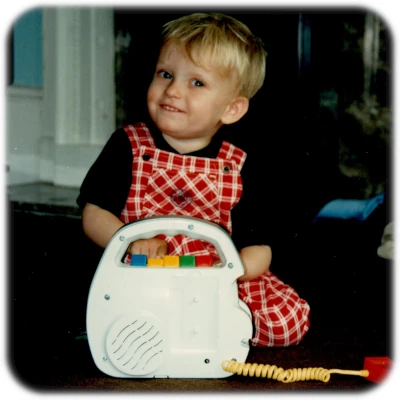
A recent photo...
Once I had got the hang of repair and modification I started designing my own audio circuits, using the discrete transistor designs of the 1970s that could be found in service manual online as examples. Some of my first projects were phono preamps that I built for my collection of pre 1954 records that needed all sorts of high frequency filtering and equalisation to sound their best, as well as low noise versions for my better records.
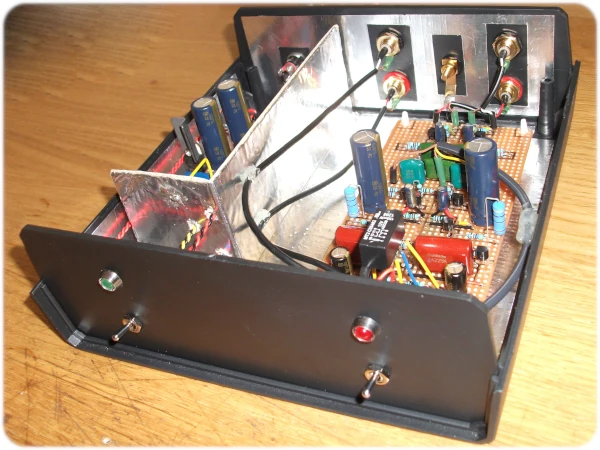
Discrete RIAA phonostage (2011)
A lot of these projects had varying degrees of success, as at the time I didn't have a proper distortion analyser and had to make-do with sound cards and basic software to see what was going on, but I soon learned that the circuits that gave the best connection to the music also measured very well too. Spending my school lunch breaks in the electronics lab, I began to use op-amps in my designs, pilfering old TL082s from the supply cabinet for home use.
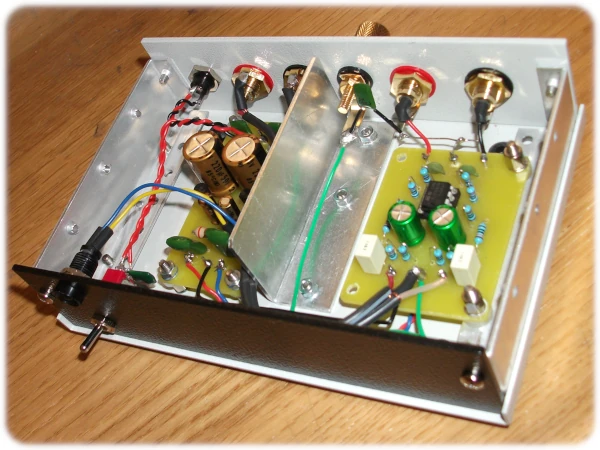
Flat level phonostage for 78 RPM transfers (2012)
After playing around with valves and discrete transistors a bit more and building a couple of power amplifiers, I decided that op-amps with split supplies were the way to go for low-level audio and made a hobby out of designing and building various HiFi circuits this way. By then I had a few years experience working in electronics and ended up working at an avionics company not far from my current base of operations. I set up Classic Audio as a side operation as I had plenty of days off, but as the work at my main job was so dull and most audio products were so uncompetitive I decided to go full-time in November 2021 and haven't looked back.
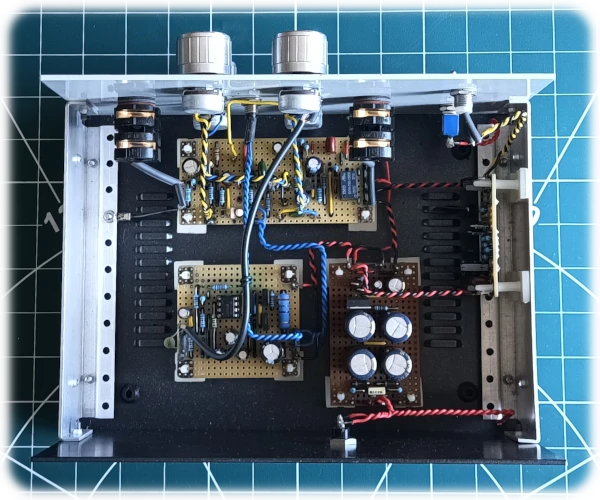
Filament lamp optical compressor (2014)
I still enjoy making effects units, listening to records, and collecting 78s, hoping to release a phonostage for the latter this year. I currently use an Audio Technica AT-LP140XP for 78s and old LPs fitted with retipped XP3 cartridges, and a Technics SL-1200GR for my LPs with an AT VM540ML and MM PRO phonostage. Currently I'm using Tannoy Gold 8 loudspeakers which work very nicely through a balancing box from the output of my old modified 1970s receiver. Some things never change!

